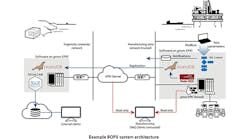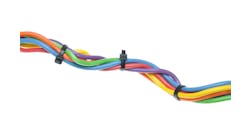Learn more on how to optimize with the Industrial Internet of Things in the series.
While the Industrial Intetrnet of Things (IIoT) is initially known for simplifying networking and enabling new connections, once these links are in place, users can venture to formerly inaccessible applications, access exotic data, and use it in previously unusual ways, such as testing, esoteric condition monitoring and others.
For instance, Engenuity Inc. in Conroe, Tex., provides control automation and data integration for oil and gas and other industries, and recently found deficiencies in validation pressure testing of blowout preventers (BOP) and well-control devices. Because pressure tests are needed every few weeks for regulatory compliance, executed and recorded manually over several hours, and can cost up to $6 per second to run in offshore valve arrays, testing can cost millions of dollars per year. To reduce these expenses, Engenuity collaborated with clients like Shell International Exploration and Production Co., and developed automated, hydrostatic, test execution and reporting solutions, which use Opto 22's groov Edge Programmable Industrial Controller (EPIC) for process control, automatic notification, and process history storage and replication.
First, BOPX testing software lets users map valve arrays and identify validation pressure limits for each device. It uses patented, constant-pressure/variable-volume pumping to bring systems to pressure, while precisely measuring injected fluid and objectively comparing measuring against validation criteria. Second, Engenuity's EZ Valve retrofit table actuator works with BOPX test manager to add automated monitoring and control to manual valve arrays, and can actuate as many as 70 valves through as many as 30 test sequences. Third, Engenuity’s EZ Vision readout uses an acoustical, leak-detection system to pinpoint leaks in large-manifold systems. Collected data can be mapped between tests for comparison and reliability, and generate PDF reports. Depending on an installation’s size and operations, testing with BOPX standardized on groov EPIC can reportedly save 10-20 hours for each full test with a fully integrated system.
Secure links for process modeling
BOPX also performs modeling, analytics and presentation functions, while groov EPIC provides a configurable firewall and two ports, including one linked to an untrusted demilitarized zone (DMZ), and the other linked to a trusted manufacturing zone for I/O and control communications. This design prevents traffic between the ports, so there's no risk of tampering with configuration, execution or process data via untrusted links on the trusted network. These secure connections let BOPX and groov EPIC run test scenarios. Usually, automated valve manifolds and EZ Valve and EZ Vision connections are integrated directly into groov EPIC’s local I/O modules, but if lots of high-speed processing is needed (typically in the 3-4 millisecond range), then Engenuity sometimes uses a separate groov EPIC as remote I/O. In this case, the remote groov EPIC handles control independently, and reports back to the primary edge controller.
While tests are performed, the primary controller monitors the process. “We have an alarm system we developed over decades,” says Ted Royer, controls engineer Engenuity. “It runs in the controller, not the HMI, so it’s available to other systems.” These include external email and messaging services, which the control program that's written in PAC Control contacts to generate email and text notifications for a range of conditions. The primary controller also stores process data generated during testing to an internal MariaDB server, which is an open-source, database management system available in a cryptographically signed package from Opto 22’s Linux repository. Using the free, secure shell (SSH) license for groov EPIC, Engenuity can download and install this and other applications for execution on its edge controller. To transfer data from the control engine to the database, Engenuity uses Node-RED open-source IoT platform pre-installed and integrated onto groov EPIC’s management layer. Node-RED provides functions for connecting and processing data from different sources, including devices, databases and web services. Next, Engenuity configures Node-RED to monitor I/O, process variables and events, and transmit this data to the internal MariaDB server (Figure 1).
Replicate for information access
Because testing data is used to validate the safety and efficacy of BOPs and similar systems, users need frequent access to process histories, and often require added protection to ensure data integrity. Engenuity does it with MariaDB’s built-in replication function.
“On an oil rig, operators typically have WiFi connecting to equipment, which isn’t super reliable when they want to log in and see data from previous runs,” says Royer. “Sometimes they want to pull massive amounts of records or even entire jobs onto an Excel spreadsheet. It doesn’t have to be real-time though, so for a BOPX system architecture, we'll set up another controller in the office that serves as a replica for the one in the field.”
Periodically, MariaDB in the onshore replica requests database replication from the offshore primary controller. The primary MariaDB server sends a transaction log to the replica, which updates itself. Instead of burdening the primary groov EPIC with large data requests, users can connect to the replica, which gives them data redundancy and high availability. “We have plenty of bandwidth in the office, so they get the best of both worlds,” adds Royer.
To facilitate secure data exchange with the primary edge controller, Engenuity joins the replica controller to the offshore manufacturing zone network using a point-to-point VPN connection. Engenuity then grants customers read-only credentials to this private network. In fact, every replica controller in Engenuity’s office connects to the outside through a separate, dedicated VPN appliance. “It’s simple and as bulletproof as we could make it,” adds Royer.
Better data distribution
If a client wants to distribute process data beyond one site, Engenuity uses groov EPIC’s integration with Ignition Edge software from Inductive Automation. Like Node-RED, Ignition is preinstalled on all groov EPICs. It most often provides OPC UA integration of third-party devices and PLCs. However, Ignition also has a modular architecture that lets users install added components, including connectivity solutions from third-party provider Cirrus Link Solutions. These include cloud injector modules that let groov EPIC send OPC tag data directly to cloud-computing services, where users worldwide can access testing data.
Beyond efficient testing, Royer adds there are other advantages to using stable groov EPIC I/O and controls that can tell users what’s wrong. "I’ll get a text from the control system in the middle of the night, and I’m already logged in by the time they call me, says Royer. "I can tell them exactly where the problem is, and it's usually something simple.”
[sidebar id=2]
Likewise, automated testing and high uptime let Engenuity's clients reduce onsite staff and adapt more easily to remote operations, and gain further value from equipment that can be installed in the field. “They don’t have space for racks of servers," adds Royer. "These IT rooms are non-classified areas in the middle of hazardous areas. They need air conditioning and so on to keep their IT equipment going. They're also designed to be half full, but they're usually overfull. So, now they can replace that situation with devices that can go outside in a NEMA 4 box. Plus, our groov EPIC has nine servers on it, and we haven’t even taken up one foot of space. And, if we need another one, it’s only another $1,500. You can't do this with traditional controllers. That’s been the big leap with Opto 22—the hybrid controller lets us do it all.”






